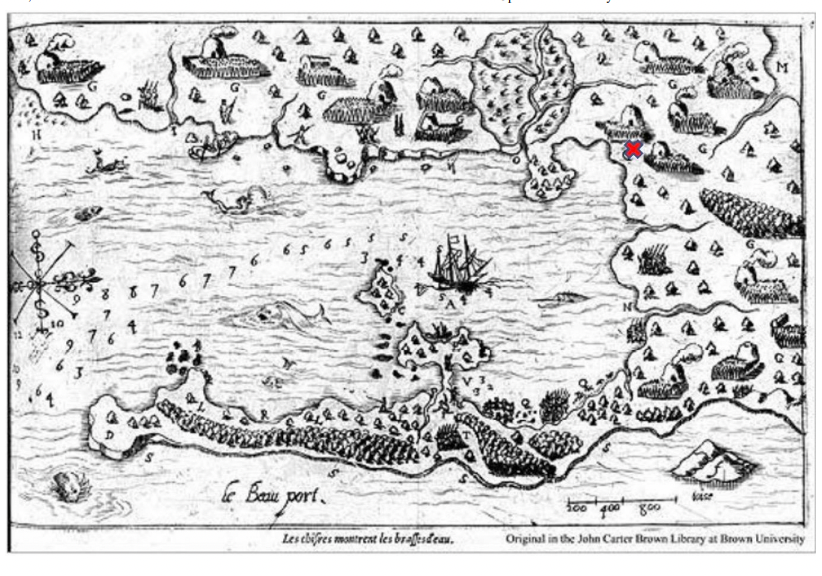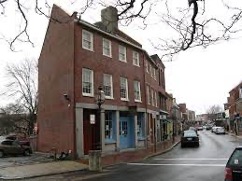Indigenous History on Babson Front Street Site, Gloucester
By Mary Ellen Lepionka
Isabel Babson immigrated to Salem in 1637, a widow at the age of 60, and in 1642 bought a house lot on Front Street in Gloucester. Front Street exists as Main Street today. In 1938 Gloucester Harbor’s shoreline was modified for the construction of the Jodrey State Fish Pier. Intertidal areas, shallow beaches, and submerged lands were filled in. In the 1950s the filled land was expanded from the state fish pier to Harbor Cove, creating Rogers Street. At the time that Isabel Babson lived on Front/Main Street, however, her property was on the waterfront. It was also on the site of land that Champlain had identified in 1606 as the site of Pawtucket wigwams and kitchen gardens, and the presence of Native people and their medicinal plants were likely important to Isabel Babson’s practice as a midwife and healer.
Along with a collection of herbs and roots Isabel used in her profession, she probably brought with her from England a copy of Gervase Markham’s The English Housewife, Containing The inward and outward Vertues which ought to be in a Compleat Woman as her skill in Physicke, Chirurgery, Cookery, Extraction of Oyles, Banqueting stuff, Ordering of Great Feasts and The English Husbandman. This book, first published in 1613, had become a classic, indispensable to literate English women in the yeomanry and gentry classes. Perhaps she had a copy of Dodoen’s Herball.
Herbology was crucial to her practice, but many of the plants in New England differed from those of Old England. Isabel would have sought information about native plants. She might have read Thomas Hariot’s account of Algonquian life in Virginia in 1588. Hariot wrote how the Indigenous people used sassafras, for example, in various cures. In 1638, John Josselyn toured New England and returned to London to publish New England’s Rarities Discovered, in which he presented “The Physical and Chyrurgical Remedies Wherewith The Natives Constantly Use To Cure Their Distempers, Wounds and Sores.”
 But she also likely learned about Native plants and remedies directly from Indigenous healers still present on Cape Ann at the time of her practice. Colonial records describe the important contributions Indigenous botanical knowledge made in developing a pharmacopeia for the “New Jerusalem.” “Native American medicine was not in conflict with techniques introduced by the first [colonial] practitioners. Instead, there was a favorable exchange of ideas, a factor which obscures the [Indigenous] derivation of many of the colonial remedies” (Gifford, p. 271). Isabel probably grew medicinal herbs on additional land granted to her in 1644, and likely became acquainted with Algonquian herbalists living on Cape Ann at the time. The next street up from Front Street was Cornhill Street, later called Middle Street, where local Pawtucket women were tending crops. They had a thriving trade in selling herbal remedies to the colonists.
But she also likely learned about Native plants and remedies directly from Indigenous healers still present on Cape Ann at the time of her practice. Colonial records describe the important contributions Indigenous botanical knowledge made in developing a pharmacopeia for the “New Jerusalem.” “Native American medicine was not in conflict with techniques introduced by the first [colonial] practitioners. Instead, there was a favorable exchange of ideas, a factor which obscures the [Indigenous] derivation of many of the colonial remedies” (Gifford, p. 271). Isabel probably grew medicinal herbs on additional land granted to her in 1644, and likely became acquainted with Algonquian herbalists living on Cape Ann at the time. The next street up from Front Street was Cornhill Street, later called Middle Street, where local Pawtucket women were tending crops. They had a thriving trade in selling herbal remedies to the colonists.
Indigenous women had effective treatments and practices relating to menstruation, venereal disease, fertility, contraception, abortion, pregnancy, labor, childbirth, breastfeeding, and neonatal care, all of which would have been in Isabel’s purview. For discomfort during pregnancy Algonquian women administered decoctions of meadowsweet with the inner bark of slippery elm, a natural aspirin, and a tea with ginger root and chamomile for morning sickness. Other treatments for women included calendula and evening primrose to induce labor; juniper berries boiled with hemlock needles and false Solomon seal for a muscle relaxant to ease the pain of contractions; wintergreen and plantain leaves to chew during labor to help with pain; skunk cabbage and lettuce sap as a sedative, if needed; chokecherry bark and horsetail to help expel afterbirth; stinging nettle and butterfly weed poultices to stop hemorrhage; decoction of swamp dogwood bark, a natural quinine, for postpartum pain and to prevent infection; tinctures of black cohosh and infusions of tansy and sweet flag flowers and leaves for amenorrhea, dysmenorrhea, and menopause; essential oils such as bee balm for external pain, and salves made from dock and jewelweed for stretch marks and irritated skin; cedar- and goldenrod-steeped water for baby’s first bath; a poultice of yarrow to release breastmilk; teas of the seeds of wild carrot with willow leaves for contraception; lobelia, sumac root, and nightshade for venereal disease; viburnum root bark to strengthen the womb; pearly everlasting and partridge berry with sarsaparilla to increase fertility; Helleborus to prevent miscarriage; and some combination of mint, blue cohosh, American pennyroyal, fleabane, and ginger leaves to cause miscarriage; and the list goes on.

1606 Champlain Map of Gloucester Harbor – Isabel Babson’s house marked with red X.
 The historic Front Street Block, erected in 1851 in the west end, 55-71 Main Street, overlies Isabel’s Babson’s original houselot, lot, believed to have been at number 69. At Isabel’s death in 1661, her property passed to her son James Babson the cooper. At that time her estate was valued at £27 6s. The Main Street property was owned by Babsons for about 150 years and was reacquired in 1961 by Roger Babson. Today it is the site of the Isabel Babson Memorial Library, established by Roger Babson to commemorate his forebear’s career in Gloucester as a greatly esteemed nurse and midwife known as “Mother Babson”.
The historic Front Street Block, erected in 1851 in the west end, 55-71 Main Street, overlies Isabel’s Babson’s original houselot, lot, believed to have been at number 69. At Isabel’s death in 1661, her property passed to her son James Babson the cooper. At that time her estate was valued at £27 6s. The Main Street property was owned by Babsons for about 150 years and was reacquired in 1961 by Roger Babson. Today it is the site of the Isabel Babson Memorial Library, established by Roger Babson to commemorate his forebear’s career in Gloucester as a greatly esteemed nurse and midwife known as “Mother Babson”.
Isabel Babson was an enterprising, mature, professional woman. She was steeped in Puritan mores and pre-Enlightenment medicine, but very likely welcomed information from Indigenous women about new resources for the many issues involved in the health and safety of women and children. The reading room in her name on Main St., a stone’s throw from the Pawtucket settlement, is an apt memorial.

Isabel Babson Memorial Library
The sources for this article are:
Babson, John James
1860 History of the Town of Gloucester, Cape Ann: Including the Town of Rockport, Samuel Chandler, Procter Brothers, Gloucester MA.
Babson, Andrew N. C.
2022 The Isabel Babson Memorial Library and Midwifery in the Seventeenth Century. Babson Historical Association: https://babsonassoc.org/isabel-babson-memorial-library/.
Cole, Bob
2018 The Very Future of Our Nation: How Aboriginal Midwifery Represents a Practical Model for Utilization of Traditional Knolwedge, Journal of Integrated Studies 10 (1):1- 22.
Essex County, Massachusetts Probate Records 1635-1681
Gifford, George E.
2017 Botanic Remedies in Colonial Massachusetts 1620-1820, Vol. 57: https://www.colonialsociety.org/node/1215.
Hutchins, A.R.
1973 Indian Herbology of North America. Shambala Publications, Boston MA>
Tantaquidgeon G.
1972 Folk medicine of the Delaware and related Algonkian Indians. Pennsylvania Historical and Museum Commission, Harrisburg PA.
Wilbur, A.R.
2004 Gloucester Harbor Characterization: Environmental History, Human Influences, and Status of Marine Resources. Massachusetts Office of Coastal Zone Management, Boston, MA.
